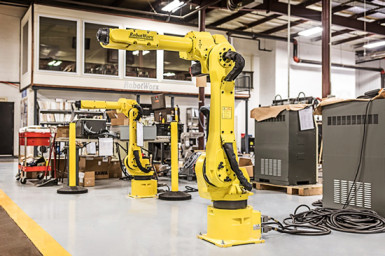We often hear about robotic arms in various industries, but most of us do not fully understand what they are. Industrial robotic arms are equipped with programmable software that allows them to execute tasks accurately and quickly.
Industrial robotic arms are mainly driven by a motor and are primarily used for repetitive and heavy-duty industrial production tasks. A standard industrial robot arm has several articulations, joints, and manipulators that resemble a human arm’s motions. A robotic arm can operate independently or as a part of a larger machine.
Numerous robotic arms used in various manufacturing industries are electronically controlled and mounted on benchtops. Larger robotic arms may be floor-mounted and made from durable and sturdy cast iron or steel. Most robot arms have four to six articulated joints, and as mentioned, they resemble the human arm, from the wrist, forearm, elbow, and shoulder.
There are various types of industrial robot arms:
- Cartesian (gantry) robotic arms
- Cylindrical robotic arms
- Polar/Spherical robotic arms
- SCARA robotic arms
Robotic Arm Advantages
An industrial robotic arm has many advantages such as:
- Improved ROI
- Improved safety for workers
- Efficiency
- Quality consistency
- Lower operation costs
- Dexterity
Robot Arms Uses
Robotic arms are used for all industrial production types or any task that requires speed, precision, and repetitive movements. Industrial robot arm uses include:
Arc Welding
Arc welding, also known as robot welding, became popular in the 80s. The main reason for switching to arc welding is the improvement of workers’ safety. The workers faced health hazards from inhalation of deadly fumes and arc burns.
Spot Welding
Spot welding involves joining two contacting metals by passing a massive current through a spot. This melts the metal, forming a weld on the spot quickly in about ten milliseconds.
Materials Handling
Material handling robot arms are used for moving, packing, and selecting products. They also automate the moving or transfer of parts from one piece of equipment to the next. This reduces labor costs and the heavy workload from human workers.
Machine Tending
Machine tending is loading and unloading raw materials into a machine and supervising a machine while it works.
Painting
Robotic painting is mainly used in the automotive industry to paint vehicles. The robotic arm paints a larger surface area with consistency and accuracy that a human hand cannot. The robotic arm also reduces reworking and saves on costs that you would have incurred.
Picking, Packing, and Palletizing
Before the final shipping of a product, it goes through constant handling. The robot arm picks and packages the products at high speed and accuracy, improving production and lowering costs.
Assembly
Robot arms assemble products in industries, which eliminates the tedious tasks for human workers. Robot arms improve the output and also minimize operational costs.
Mechanical Grinding, Cutting, or Polishing
Robot arms have more agility, which provides manufacturers with an option that other industrial robots cannot offer. An example is the manufacture of orthopedic implants like hip and knee joints. The polishing of these parts can take a human 45 to 90 minutes to complete, while a robot takes only a few minutes.
Adhesive Sealing, Gluing, and Spraying Materials
Sealer robots have various robot arm configurations that allow the robot to apply adhesives to any product. This improves the speed, consistency, and quality of the finished product.
Conclusion
The industrial robotic arm serves various purposes and is more common today than it used to be. Most manufacturing industries have seen the value of using robotic arms to improve safety, improve ROI, efficiency, accuracy, and lower operating costs.
The robotic arms serve numerous purposes, chief among them being the dexterity or agility they offer. The robotic arm can handle delicate operations that the industrial robot cannot. This makes more manufacturers consider the robotic arm as a better option to the bulkier industrial robots. The industrial robotic arm can either be mounted on a bench top, the floor, or can be part of a larger machine.












































































